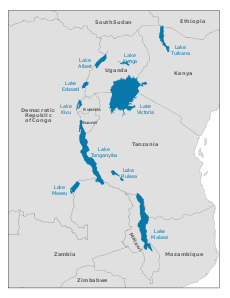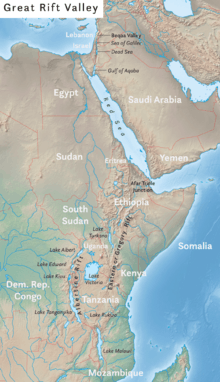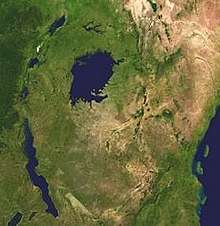African Great Lakes
The African Great Lakes (Swahili: Maziwa Makuu) are a series of lakes constituting the part of the Rift Valley lakes in and around the East African Rift. They include Lake Victoria, the second-largest fresh water lake in the world by area, Lake Tanganyika, the world's second-largest freshwater lake by volume and depth, and Lake Malawi, the world's eighth-largest fresh water lake by area.[1] Collectively, they contain 31,000 km3 (7400 cu mi) of water, which is more than either Lake Baikal or the North American Great Lakes. This total constitutes about 25% of the planet's unfrozen surface fresh water. The large rift lakes of Africa are the ancient home of great biodiversity, and 10% of the world's fish species live there.



Countries in the African Great Lakes region (sometimes also called Greater Lakes region) include Burundi, the Democratic Republic of the Congo, Kenya, Malawi, Rwanda, Tanzania and Uganda.[2]
Lakes and drainage basins
The following are included on most lists of the African Great Lakes, grouped by drainage basin. The exact number of lakes considered part of the African Great Lakes varies by list, and may include smaller lakes in the rift valleys, especially if they are part of the same drainage basin as the larger lakes, such as Lake Kyoga.
Drains into the White Nile river
- Lake Victoria
- Lake Albert
- Lake Edward
Drain into the Congo River
Drains into the Zambezi via the Shire River
African Great Lakes Region
The African Great Lakes region consists of countries that surround the African Great Lakes. It comprises Burundi, the Democratic Republic of the Congo, Kenya, Malawi, Rwanda, Tanzania and Uganda.[2]
The Bantu Swahili language is the most commonly spoken language in the African Great Lakes region.[3] It also serves as a national or official language of five nations in the region: Tanzania, Kenya, Uganda, Rwanda and the Democratic Republic of the Congo.
Due to the high population density of an estimated 107 million people, and the agricultural surplus in the region, the area became organized into a number of small states. The most powerful of these monarchies were Buganda, Bunyoro, Rwanda, and Burundi. Unusual for sub-Saharan Africa, the traditional borders were largely maintained by the colonial powers, however the national borders were often drawn to divide monarchies that the colonials did not favor or to keep preferred groups in relative dominance over groups perceived as less euro-centric.
Being the long-sought source of the Nile, the region had long been of interest to Europeans. The first Europeans to arrive in the region in any numbers were missionaries who had limited success in converting the locals, but did open the region to later colonization. The increased contact with the rest of the world led to a series of devastating epidemics affecting both humans and livestock. While seen as a region with great potential after independence, the region has in recent decades been marred by civil war and conflict, which only Tanzania has escaped. According to the UNHCR, Tanzania hosted the most Congolese refugees of the region. The worst affected areas have been left in great poverty.[4]
Climate
The highlands are relatively cool, with average temperatures ranging between 17 °C (63 °F) and 19 °C (66 °F) and abundant rainfall. Major drainage basins include those of the Congo-Zaire, Nile, and Zambezi rivers, which drain into the Atlantic Ocean, Mediterranean Sea, and Indian Ocean, respectively.
Forests are dominant in the lowlands of the Congo-Zaire Basin, while grasslands and savannas are most common in the southern and eastern highlands. Temperatures in the lowlands average about 95 °F (35 °C). Around Lake Turkana, the climate is hot and very dry. A short rainy season in October is followed by a longer one from April to May.
Flora and fauna
The Western Rift Valley lakes are freshwater and home to an extraordinary number of endemic species. More than 1,500 cichlid fish species live in the lakes,[5] as well as other fish families. The lakes are also important habitats for a number of amphibian species. Nile crocodiles are numerous. Mammals include elephants, gorillas and hippopotamus.
The Lake Turkana area is home to hundreds of species of birds endemic to Kenya. The flamingo wades in its shallows. The East African rift system also serves as a flyway for migrating birds, bringing in hundreds more. The birds are essentially supported by plankton masses in the lake, which also feed the fish there.
Vegetation ranges from rainforest to savanna grasses. In some lakes, rapidly growing invasive plants, like the surface-choking water hyacinth and shore-clogging papyrus, are problems. Water hyacinth have thus far affected only Lake Victoria.
Geology
Until 12 million years ago, the bountiful waters of the equatorial plateau either flowed west into the Congo River system or east to the Indian Ocean. Creation of the Great Rift Valley changed that. A rift is a weak place in Earth's crust due to the separation of two tectonic plates, often accompanied by a graben, or trough, in which lake water can collect. This rift began when East Africa, impelled by currents in the mantle, began separating from the rest of Africa, moving to the northeast. The basins that resulted from the geological uplifts filled with water that now flowed north.
Lake Victoria is not actually within the Rift Valley. It occupies a depression between the Eastern and Western Rifts, formed by the uplift of the rifts to either side.
Archaeology
Around two to three million years ago, Lake Turkana was larger and the area more fertile, making it a center for early hominids. Richard Leakey led numerous anthropological excavations in the area, which yielded many important discoveries of hominin remains. The two-million-year-old Skull 1470 was found in 1972. It was originally thought to be Homo habilis, but some anthropologists have assigned it to a new species, Homo rudolfensis, named after the lake (previously known as Lake Rudolf). In 1984, the Turkana Boy, a nearly complete skeleton of a Homo erectus boy was discovered. More recently, a 3,500,000-year-old skull was discovered there, named Kenyanthropus platyops, which means "The Flat-Faced Man of Kenya".
Economy
Fishing—primarily of tilapia species but also of Nile perch—provides the main livelihood. With four Great Lakes on its borders, Uganda ranks as one of the world's largest producers of freshwater fish. The climate and rich volcanic soils in the highlands also sustain intensely cultivated croplands.
The economies of the Great Lakes region states have different structures and are at various stages of development. The GDP real growth rate ranges from 5.1 percent in Burundi to 6.4 in DRC. GDP per capita fluctuates between $700 in DRC and Burundi and $1,900 in Uganda.
Geopolitics
The Great Lakes area, where colonial era borders cut through ethnic groups, has in the last 20 years been a crucible of conflict that has launched multiple uprisings and invasions.[6] The United Nations, the United States, and several European countries have special envoys or representatives to the Great Lakes region. Local populations recently have denounced the presence of these 'agency' groups like the UN, saying they often do not actually prevent attacks or protect local villages,[7] but are posted for whitewashing purposes or to safeguard western envoys, citizens and their business interests.[8] They have also been accused by both local and other African nations of participating in human rights abuses and rampant sex-based exploitation and trafficking.[9]
See also
Notes
- "~ZAMBIA~". www.zambiatourism.com. Retrieved 2008-03-14.
- "International Documentation Network on the Great African Lakes Region". Princeton University Library. Retrieved 22 November 2013.
- Shema, Rutagengwa Claude. "Great Lakes Region of Africa – Burundi". Regional Coordinator Great Lakes Peace Initiative (GLPI). Retrieved 22 November 2013.
- "Great Lakes Region News". UNHCR. Retrieved 22 October 2015.
- Turner; Seehausen; Knight; Allender; Robinson (2001). "How many species of cichlid fishes are there in African lakes?". Molecular Ecology. 10 (3): 793–806. doi:10.1046/j.1365-294x.2001.01200.x.
- Editorial, Reuters. "UPDATE 4-African leaders sign deal aimed at peace in eastern Congo".
- Moloo, Zahra (18 January 2016). "UN peacekeepers in the DRC no longer trusted to protect". Al Jazeera.
- "DRC blames UN after eight hurt in student protest". News24. 15 May 2018.
- "S Africa sacks UN Congo peacekeepers over curfew breach". Al Jazeera. 19 November 2015.
References
| Wikimedia Commons has media related to African Great Lakes. |
- Chrétien, Jean-Pierre (2006). The Great Lakes of Africa: Two Thousand Years of History. Translated by Straus, Scott. New York: Zone Books. ISBN 1-890951-35-8.